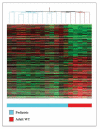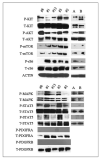Molecular characterization of pediatric gastrointestinal stromal tumors
- PMID: 18483389
- PMCID: PMC3805121
- DOI: 10.1158/1078-0432.CCR-07-1984
Molecular characterization of pediatric gastrointestinal stromal tumors
Abstract
Purpose: Pediatric gastrointestinal stromal tumors (GIST) are rare and occur preferentially in females as multifocal gastric tumors, typically lacking mutations in KIT and PDGFRA. As KIT oncoprotein is consistently overexpressed in pediatric GIST, we sought to investigate the activation of KIT downstream targets and alterations of KIT/PDGFRA gene copy number, mine novel therapeutic targets by gene expression, and test tyrosine kinase receptor activation by proteomic profiling.
Experimental design: Seventeen pediatric GISTs were investigated for KIT/PDGFRA genotype and biochemical activation of KIT downstream targets. The transcriptional profile of 13 nodules from 8 pediatric patients was compared with 8 adult wild-type (WT) GISTs, including 3 young adults. The drug sensitivity of second-generation kinase inhibitors was tested in murine Ba/F3 cells expressing human WT KIT, as well as in short-term culture of explants of WT GIST cells.
Results: A KIT/PDGFRA WT genotype was identified in all 12 female patients, whereas two of five males had either a KIT exon 11 or PDGFRA exon 18 mutation. KIT downstream targets were consistently activated. Pediatric GISTs showed a distinct transcriptional signature, with overexpression of BAALC, PLAG1, IGF1R, FGF4, and NELL1. In vitro studies showed that nilotinib, sunitinib, dasatinib, and sorafenib are more effective than imatinib against WT KIT.
Conclusions: Rare cases of pediatric GIST may occur in male patients and harbor activating KIT/PDGFRA mutations. Pediatric GISTs show distinct transcriptional signature, suggesting a different biology than WT GIST in adults. In vitro drug screening showed that second-generation kinase inhibitors may provide greater clinical benefit in pediatric GIST.
Figures






References
-
- Miettinen M, Lasota J, Sobin LH. Gastrointestinal stromal tumors of the stomach in children and young adults: a clinicopathologic, immunohistochemical, and molecular genetic study of 44 cases with long-term follow-up and review of the literature. Am J Surg Pathol. 2005;29:1373–81. - PubMed
-
- Prakash S, Sarran L, Socci N, et al. Gastrointestinal stromal tumors in children and young adults: a clinicopathologic, molecular, and genomic study of 15 cases and review of the literature. J Pediatr Hematol Oncol. 2005;27:179–87. - PubMed
-
- Antonescu CR, Sommer G, Sarran L, et al. Association of KITexon 9 mutations with nongastric primary site and aggressive behavior: KIT mutation analysis and clinical correlates of 120 gastrointestinal stromal tumors. Clin Cancer Res. 2003;9:3329–37. - PubMed
-
- Agaram NP, Besmer P, Wong GC, et al. Pathologic and molecular heterogeneity in imatinib-stable or imatinib-responsive gastrointestinal stromal tumors. Clin Cancer Res. 2007;13:170–81. - PubMed
-
- Antonescu CR, Viale A, Sarran L, et al. Gene expression in gastrointestinal stromal tumors is distinguished by KIT genotype and anatomic site. Clin Cancer Res. 2004;10:3282–90. - PubMed
Publication types
MeSH terms
Substances
Grants and funding
LinkOut - more resources
Full Text Sources
Other Literature Sources
Research Materials
Miscellaneous

